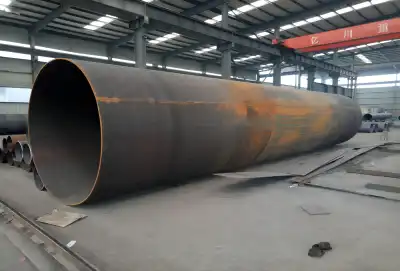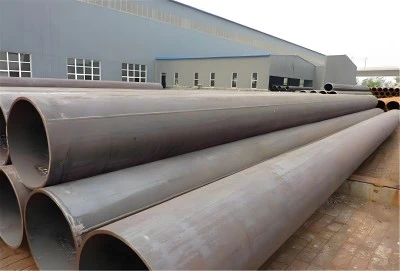Straight Seam Welded Pipe is a steel pipe:
Straight Seam Welded Pipe is a kind of steel pipe that is used in a lot of different industries, like transportation of oil and gas, construction, and building new infrastructure. As its name recommends, this line is portrayed by a constant longitudinal weld crease that runs along its length. A strong and dependable product is made by welding the edges of a flat steel plate or coil that has been shaped into a cylinder.
Due to their cost-effectiveness, adaptability, and capacity to meet a wide range of performance requirements, the products have gained popularity. Most of the time, these products are made of high-quality steel, which, when treated properly, has excellent strength, durability, and resistance to corrosion.
The uniform wall thickness of the products is one of their primary advantages. The products, on the other hand, have a consistent thickness throughout their entire length, as opposed to seamless pipes, which may have varying wall thicknesses due to the manufacturing process. This uniformity is especially helpful in situations where precise pressure ratings or flow calculations are required.
From small-diameter products used in residential plumbing to large-diameter products used in major pipeline projects, the products are available in a wide range of sizes. These products can have a diameter of a few inches to more than 100 inches, and their wall thicknesses can be adjusted to meet various pressure requirements and applications.
Depending on the intended use, the products can be made of carbon steel, low-alloy steel, or stainless steel. Due to their low cost and excellent mechanical properties, carbon steel pipes are frequently utilized for general purposes. Improved toughness and strength make low-alloy steel pipes suitable for more demanding applications. The products made of stainless steel are frequently used in chemical processing, food production, and other industries where material purity is important because of their excellent resistance to corrosion.
|
|
|
Straight Seam Welded Pipe Manufacturing Process:
Straight seam welded pipe is produced through a series of steps, each of which is essential to ensuring that the finished product satisfies the required specifications and quality standards. The selection of the appropriate steel, typically in the form of hot-rolled coils or plates, is the first step in the process. The selection of a steel grade is determined by the intended use of the product, taking into account requirements for strength, corrosion resistance, and operating conditions.
Edge preparation is the first step in the actual formation of the product. The steel curl or plate edges are managed to guarantee they are straight and clean, which is fundamental for accomplishing a top notch weld. The steel is then gradually shaped into a cylinder by passing through a series of forming rolls. Roll forming is a process that is carefully controlled to get the diameter and roundness of the product that you want.
The edges of the steel are joined for welding after it has been shaped into a cylinder. For the products, the following are the most common welding techniques:
1. Welding with Electric Resistance (ERW): This approach is typically applied to the products with a diameter of less than 24 inches. By passing an electric current through them, the edges of the steel in ERW are heated to the temperature required for welding. After that, pressure is applied to forge the heated edges together, resulting in a filler-free solid-state weld.
2. SAW (Submerged Arc Welding): For the products with thicker walls and larger diameters, this method is preferred. To safeguard the weld area, SAW makes use of a separate granular flux and an automatically fed electrode wire. It is possible to produce very thick-walled products using this method, which can be used for both single and multiple passes of welding.
3. Welding with High Frequency Induction (HFI): HFI welding, like ERW, heats the edges of the steel with high-frequency electrical current. Welds of high quality can be made quickly using this method.
The product goes through several finishing steps after being welded. Heat treatment to lessen stress in the weld area, straightening to make sure the pipe meets straightness tolerances, and sizing to get the final diameter you want are examples of these. After that, the ends of the pipe are faced and sometimes beveled to get them ready for field welding during installation.
Finally, based on their intended use, the products are given a variety of surface treatments. This could involve painting, cleaning, or applying specialized coatings to prevent corrosion. In order to improve their durability and resistance to the effects of the environment, the products may also be subjected to galvanization or other surface hardening procedures.
Straight Seam Welded Pipe Quality Inspection Method:
In the production of straight seam welded pipe, quality control is an essential component. Throughout the manufacturing process, stringent inspection procedures are used to guarantee that the products meet or exceed customer specifications and industry standards. Non-destructive testing (NDT) and destructive testing are the two main types of inspection techniques.
Because they enable complete inspection of the products without jeopardizing their integrity, non-destructive testing techniques are particularly crucial. The most important NDT techniques include:
1. Testing by ultrasonics (UT): Internal defects in the weld seam and product wall can be detected using this method, which employs high-frequency sound waves. Cracks, inclusions, and a lack of fusion are just a few of the problems it can spot. For continuous weld seam inspection, automated ultrasonic testing systems are frequently integrated into the production line.
2. Tests with Eddy Currents: When it comes to finding defects in the products' surface and near-surface, this electromagnetic method is especially helpful. To ensure a thorough inspection, it is frequently used in conjunction with other testing methods.
3. Tests by radiography (RT): In order for inspectors to locate internal flaws, images of the product wall and weld seam are created using X-rays or gamma rays. RT is frequently used for spot checks or when customers specify it, but it is not typically used for 100% inspection due to time and cost considerations.
4. MPI or Magnetic Particle Inspection: In ferromagnetic materials, this method is used to find defects near and on the surface. It is especially useful for locating cracks and other linear defects in the product body and weld seam.
5. Hydrostatic Analysis: Hydrostatic testing is an important quality control measure, even though it is not strictly an NDT method. In order to check the strength and leak-tightness of the product, it is filled with water and pressurized to a pressure higher than its design pressure.
Destructive testing is performed on sample products from each production batch in addition to these NDT methods. Some of these tests might be:
1. Tests of Tension: to confirm the weld seam and material of the product's strength.
2. Testing to Flatten: to verify the weld's strength and the product's ductility.
3. Tests of Guided Bend: to determine the strength and ductility of the weld.
4. Impact Evaluation: to determine the material's toughness, which is especially important for the products that are used in low-temperature environments.
5. Examination Metallographically: to check the product material's microstructure before welding and making sure the heat treatment and welding are done right.
The products meet the high standards required for their various applications, such as oil and gas transportation and structural use in buildings and bridges, thanks to these comprehensive inspection techniques.
Straight seam welded pipe exporter:
When choosing a manufacturer and exporter of straight seam welded pipe, it is essential to select a business with a demonstrated track record of quality, dependability, and customer satisfaction. One such organization in the business is Longma, which offers a far reaching scope of products to meet different client needs.
The products from Longma are made using a variety of welding techniques and can be used for a variety of applications and requirements. The following are the types of welding they perform:
1. Electric Resistance Welding or ERW: ERW productes are renowned for their uniform wall thickness and smooth surface finish, making them an excellent choice for products with smaller diameters and relatively thin walls. Construction, water supply, and low-pressure oil and gas transportation all make extensive use of them.
2. Longitudinal Submerged Arc Welding or LSAW: Large-diameter, thick-walled applications requiring high strength and dependability are ideal for LSAW products. High-pressure oil and gas pipelines, offshore platforms, and structural applications frequently make use of these products.
3. Spiral Submerged Arc Welding or SSAW: For products with medium to large diameters, SSAW products provide a good balance of strength and cost-effectiveness. They are frequently used in structural, piling, and water transmission applications.
You can get in touch with Longma at info@longma-group.com to learn more about their products, services, and how they can meet your specific needs if you are in the process of selecting a manufacturer of straight seam welded pipe for your project.














